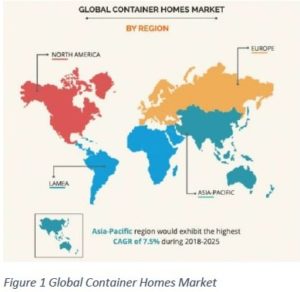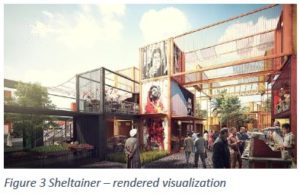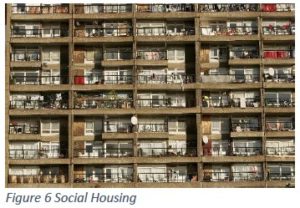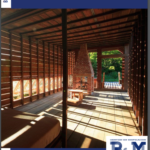Shipping Container Homes – The Houses of the Future?
Here we bring to you a very interesting post from Mutasem Al-Abweh about alternative construction with an Agile construction focus. «Shipping Container Homes» it is a very bold aproach and a very interesting way to see the Houses of the Future. Mutasem Al-Abweh is an Industrial Engineer with a Dual Master Graduate in Industrial Processes Management from the University of Burgos, Spain.

The Market Share, the Upcycle, and Criticism of Shipping Containers
 The current trend in agile construction is towards using disposed of rusting shipping containers at ports for housing. This housing can range from rental student accommodation to permanent family residences. In fact, there are more than 14 million out-of-service containers that are available in the market at a low cost. Holding a projected CAGR (Compound annual growth rate) of 6.5% from 2018 to 2025, the global container homes market size is expected to reach approximately $73,000 million by 2025 (1). In addition, a container’s modular design makes it easy to work with and re-shape. Finally, using containers means reduced consumption of natural resources, i.e., upcycling.
The current trend in agile construction is towards using disposed of rusting shipping containers at ports for housing. This housing can range from rental student accommodation to permanent family residences. In fact, there are more than 14 million out-of-service containers that are available in the market at a low cost. Holding a projected CAGR (Compound annual growth rate) of 6.5% from 2018 to 2025, the global container homes market size is expected to reach approximately $73,000 million by 2025 (1). In addition, a container’s modular design makes it easy to work with and re-shape. Finally, using containers means reduced consumption of natural resources, i.e., upcycling.
Despite the criticism of downcycling from shipping containers in an opinion article on TreeHugger (2). The article states that the containers could be used to produce steel rods instead of downcycling them for housing. However, only 7.5% of the containers will be used to build one house leaving the remaining 92.5% of the containers for melting and formation into steel rods. Thus, there are plenty of containers for industrial production.
Mode of Installation
 The added advantage of new modes of installation makes shipping containers more attractive to architects. Architects can now build container homes off-site in order to avoid causing traffic to pedestrians and cars as well as lower the probability of any noise or waste generated from construction to neighbors in the area. This leads to happier communities, in contrary to the on-site mode of installation for traditional construction sites.
The added advantage of new modes of installation makes shipping containers more attractive to architects. Architects can now build container homes off-site in order to avoid causing traffic to pedestrians and cars as well as lower the probability of any noise or waste generated from construction to neighbors in the area. This leads to happier communities, in contrary to the on-site mode of installation for traditional construction sites.
From another sector, temporary housing forrefugees or victims of natural disasters will need quick sustainable solutions. A notableexample is the Ex- Container Project in Japan that aimed at providing immediate housing for those who were displaced following the earthquake and tsunami that hit Japan on 11th of March, 2011 (3). Considering this example was around a decade ago, the mode of installation of shipping containers have proved valuable in emergency situations.
Community Empowerment
Along with other projects where houses could be built, only shipping container projects (4) have recently focused on being built by the resident him/herself. On the other hand, the opportunity for a community member to take part in constructing his/her home alongside the main construction company in the traditional construction industry does not exist. This has been further expanded upon for under-developed areas with the project entitled “Sheltainer”.
 Sheltainer, rewarded in 2018 of the World Architecture Festival’s WAFX Ethics and Value category 2018 (5), aims to re-house people in El’arafa (City of the Dead) using re-purposed shipping containers. Not only does this project aim at improving the lives of those living in El’arafa where sanitation is not properly contained, it will also employ community members to build the houses. This sense of community through hard work is unique to conventional housing (i.e., social housing), in which houses are sold/rented completely built and ready for moving in. Through Sheltainer and other community-driven projects, the sense of a community from the previous generation will emerge once again.
Sheltainer, rewarded in 2018 of the World Architecture Festival’s WAFX Ethics and Value category 2018 (5), aims to re-house people in El’arafa (City of the Dead) using re-purposed shipping containers. Not only does this project aim at improving the lives of those living in El’arafa where sanitation is not properly contained, it will also employ community members to build the houses. This sense of community through hard work is unique to conventional housing (i.e., social housing), in which houses are sold/rented completely built and ready for moving in. Through Sheltainer and other community-driven projects, the sense of a community from the previous generation will emerge once again.
On another note, Sheltainer has preserved cultural aspects in the existing community by creating pigeon lofts for caretakers of pigeons on centralized towers responsible for sanitation. To sum “community empowerment up”, a community that sweats and perseveres together is one that is stronger on a personal level than any other community ever.
Out-of-the-box Ideas for Infrastructure
 In this era of creativity and social responsibility, out-of-the-box ideas have become very welcome in the Architecture world.
In this era of creativity and social responsibility, out-of-the-box ideas have become very welcome in the Architecture world.
Back to the Sheltainer project, zero waste, a momentary global environmental concern, has been addressed. Through the implementation of ‘sanitation towers’ that are monitored by various renewable energy resources, Sheltainer is fulfilling its objective of reaching zero waste by using solar roofs, green roofs, wind catchers, etc.
Furthermore, a novel opportunity for communities to partially (if not fully) design and ‘control’ their infrastructure – in terms of heating, water and electricity – has been proposed by mobile drinking water tanks entitled WEDEW (wood-to energy deployed emergency water)(6). In short, WEDEW uses two technologies (biogasification and water generation) to turn air into drinking water while using shipping containers as its operating vessel. WEDEW in combination with Sheltainer would provide an overwhelming boost in the community’s sanitation, especially since sanitation is a main concern for the Sheltainer  project. Therefore, a large-scale remote water drinking solution like WEDEW could ‘liberate’ poor remote communities from depending on the main city’s water supply pipe to obtain clean drinking water (in addition to the instalment of conventional home-installed filters under the sink or plastic store-bought water bottles).
project. Therefore, a large-scale remote water drinking solution like WEDEW could ‘liberate’ poor remote communities from depending on the main city’s water supply pipe to obtain clean drinking water (in addition to the instalment of conventional home-installed filters under the sink or plastic store-bought water bottles).
 Ultimately, zero waste will be much easier to achieve since the community will consume less plastic, taking the case of buying plastic store-bought water bottles. Ironically, these poor communities could become richer in environmental-friendly awareness and standards than conventional city-based social housing systems. Without out of-the-box ideas, the world of architecture will remain comfortable in its ‘brick and stone’ concepts of the past consuming extensively more non-renewable resources on the planet every day.
Ultimately, zero waste will be much easier to achieve since the community will consume less plastic, taking the case of buying plastic store-bought water bottles. Ironically, these poor communities could become richer in environmental-friendly awareness and standards than conventional city-based social housing systems. Without out of-the-box ideas, the world of architecture will remain comfortable in its ‘brick and stone’ concepts of the past consuming extensively more non-renewable resources on the planet every day.
Conclusion
In conclusion, shipping containers have been around for years now in both emergency and stable living situations. What is more, however, all shipping container projects share a strong set of similarities that cement their values:
availability + inherently modular design + accessibility = quick and cheap solutions!
This formula written by me sums up all that has been previously explained. The values “availability” and an “inherently modular design” are much clearer after reading examples from before, however “accessibility” was there also from a more global approach. Accessibility was the sphere in which all other values become worth noting. Accessibility to victims of natural disasters, the disabled, to lower and upper societal classes, to all cultures, to a zero-waste environment, to a happy community is the key factor to a successful project.
With this, I hope shipping container houses (Houses of the future) have aroused your interest as much as it has mine for a healthier planet and satisfied communities.
Author
 I am both a hard worker at my job and a passionate human being that loves to give back to society. As a result of several job and internship experiences, I have gained leadership, coordination, quality assurance, agile project management, and data analysis skills. As for my social endeavours, I have a fair amount of multicultural skills as well as empathetic- and empowerment-based experiences. On top of that, I am bilingual (Arabic, English) and speak advanced German (B2 Level). I’m looking forward to mastering Spanish. Lastly, my perseverance for self-improvement drives me everyday to get up in the morning.
I am both a hard worker at my job and a passionate human being that loves to give back to society. As a result of several job and internship experiences, I have gained leadership, coordination, quality assurance, agile project management, and data analysis skills. As for my social endeavours, I have a fair amount of multicultural skills as well as empathetic- and empowerment-based experiences. On top of that, I am bilingual (Arabic, English) and speak advanced German (B2 Level). I’m looking forward to mastering Spanish. Lastly, my perseverance for self-improvement drives me everyday to get up in the morning.
Referencias
(1) Container Homes Market Size by 2025 | Competitor Analysis & Forecast (February 2019).
(2) What’s wrong with shipping container housing? One architect says ‘everything.’ | TreeHugger (2015).
(3) Ex-Container Project / Yasutaka Yoshimura Architects | ArchDaily (2011).
(4) Así será la casa prefabricada que podrás comprar en Ikea y montar tú mismo — idealista/news (2018).
(5) Shipping container micro-housing proposed for City of the Dead in Cairo (March 8, 2019).

























